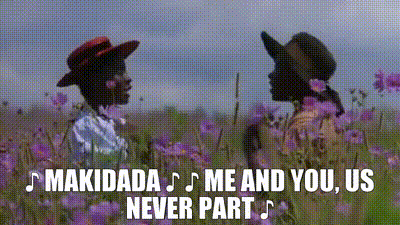"I think it pisses God off if someone walks by The Color Purple in a field somewhere and don't notice" free spirited blues singer Shug Avery tells her friend, Celie. Over the course of forty years Celie learns to find her own bit of purple amidst the tangled weeds of abuse, poverty, and tragedy that make up the field of her life. Nearly forty years after its release The Color Purple remains one of the most visceral, compelling, and inspiring films in modern cinema. Join Celie and discover the beauty of The Color Purple.
The story begins in 1910 Georgia with teen sisters Celie and Nettie playing in a field of purple flowers. The heartwarming tone is abruptly shifts when it is revealed that the girls lives are marked by poverty and abuse. In a letter to God Celie confesses that she is pregnant for the second time after years of suffering sexual abuse at the hands of her step-father. In an effort to conceal his guilt, when Celie's second child is born her step-father arranges for the bay to be adopted and Celie to be married to a neighboring farmer. She soon finds herself in even more dire circumstances when her husband subjects her to emotional, physical, and sexual abuse. In what is perhaps his greatest act of cruelty, her husband goes on to forbid her from seeing the one person who has ever shown her any real love; Nettie. Over the ensuing years Celie endures abuse and tragedy against the backdrop of a changing South. What follows is a tale of resilience and triumph in the face of adversity and a testament to the human spirit.
The Color Purple brings Alice Walker's 1985 novel to visceral life. While the film approaches the novel's difficult subject matter with sensitivity it does so without flinching from the brutal reality of Celie's existence. In this way, the film challenges viewers to confront the all too real horrors of sexual abuse, domestic violence, poverty, and prejudice without resorting to heavy handed messages or lecturing. Perhaps the films greatest success is its ability to put a human face on these issues in a way that will leave viewers contemplating their full impact long after the final credits fade. Despite its harsh subject matter, however, the film is infused with a hope, humor, and humanity that ensure the story avoids becoming offputtingly bleak without reducing its power. As a result, the film manages to be gritty without becoming gratuitous and empathetic rather than exploitative as it treats viewers to one of the most compelling experiences in modern cinema. Follow Celie for the journey of a lifetime as she discovers the meaning of The Color Purple.
The film transports viewers to the gritty reality of the turn of the century South thanks to the brilliant work of its cast. Danny Glover perfectly conveys the cruelty of Celie's husband, known only as Mister, while still infusing him with insecurity and immaturity. Oprah Winfrey is a force of nature as Celie's outspoken daughter-in-law, Sophia. Willard Pugh lends an apt comic turn as Celie's hapless step-son, Harpo. Akosua Busia infuses Nettie with warmth and quiet strength. Margaret Avery proves to be a scene stealer as Mister's former mistress turned Celie's love interest, sultry singer Shug. Whoopie Goldberg turns in the performance of her career in her portrayal of Celie's transformation from battered victim to independent and resilient survivor.All of the most inspiringly bright and devastatingly dark shades of the human experience can be found in The Color Purple. The script brings Walker's novel to visceral life as it unflinchingly depicts Celie's tragedies and triumphs. The stellar work of the cast brings each of the characters to screen with complexity and humanity. Witness the power of cinema in the beauty of The Color Purple.
 |
| I'm not crying, you're crying! |



No comments:
Post a Comment